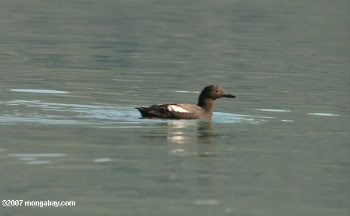Twenty years ago today—at 12:04 AM on March 24th, 1989—the Exxon Valdez tanker struck Bligh reef in Prince William Sound causing 10.8 million gallons of crude oil to spill into the sea. The spill decimated the ecosystem and wildlife for 11,000 square miles and became one of the world’s most infamous oil spills. Twenty years later, researchers say that several bird species have yet to recover from the spill.
“Analysis of the oil spills’ impacts found that a significant portion of several species’ populations were killed, including 5-10 percent of the world’s Kittlitz’s Murrelet population and 6-12 percent of the area’s population of the Marbled Murrelet,” said Dr. Michael Fry, director of Conservation Advocacy at American Bird Conservancy (ABC). “We are concerned about a number of the bird species harmed in the catastrophe such as the Kittlitz’s Murrelet whose population has yet to rebound.”
 A pigeon guillemot in Alaska. Photo by Rhett A. Butler. |
According to ABC, Kittlitz’s Murrelet’s population plummeted 99 percent from 1972 to 2004. Since the Exxon Valdez spill in 1989 the rate of decline went from 18 percent to 31 percent. Researchers also believe that climate change is negatively affecting the species.
Two other bird species, the Pigeon Guillemot and the Marbled Murrelet, have not seen significant recovery in the Prince William Sound. In fact, the Exxon Valdez Trustee Council has found that leaked oil can still be found in the Sound. Given its slow rate of dissolving, the oil may persist for decades, even centuries.
“Twenty years after the Exxon Valdez spill, oil still poses a grave threat to marine bird,”said Dr. Fry. “American Bird Conservancy would like to see an acceleration of the phase out of single hulled tankers in the U.S. which are allowed until 2015. A similar requirement for double-hulled tankers needs to be made globally to protect birds and other wildlife from future spills. Additional marine reserves and no-go zones for tankers during sensitive breeding and staging seasons should also be implemented to protect the most vulnerable species.”
Oil spills are not past occurences. On March 13th, 250 tons of oil spilled off Australia’s northeast coast, blanketing local beaches and killing wildlife. It has been called one of the worst environmental distasters in Queenland’s history.
Related articles
One third of US birds endangered
(03/19/2009)
Ken Salazar, the nation’s new Secretary of the Interior, today released the first comprehensive report on bird populations in the United States. The findings are not encouraging: nearly one third of United States’ 800 bird species are endangered with even once common species showing precipitous declines. Habitat loss and invasive species are blamed as the largest contributors to bird declines.
Global warming drives birds north
(02/11/2009)
Nearly 60 percent of the 305 species found in North America in winter have shifted their ranges northward by an average of 35 miles, according to an assessment by the Audubon Society.
U.S. Fish and Wildlife Service program restores bird habitat on farms and ranches
(10/28/2008)
Matt Filsinger is driving his white pickup headed northeast from Sterling to look at two of his projects. This self-described introvert speaks enthusiastically about his job. “Ducks, ducks, ducks – that’s what I love!” says Filsinger, grinning broadly. Filsinger is a wildlife biologist with the Partners for Fish and Wildlife Program of the U.S. Fish and Wildlife Service. He works with private landowners to set aside land and create attractive habitat for imperiled species. Specifically, he designs wetlands to attract waterfowl. Partners for Fish and Wildlife is a successful program that has been around since 1987. Landowners, including farmers and ranchers, form partnerships with the program because they reap a variety of benefits from it. Nonprofit organizations such as Ducks Unlimited, Audubon and the Rocky Mountain Bird Observatory are also partners. Collaboration between the federal government and private landowners is essential to preserving habitat and species, as 73 percent of the country’s land is privately owned, and most wildlife lives on that land.
Birds face higher risk of extinction than conventionally thought
(07/14/2008)
Birds may face higher risk of extinction than conventionally thought, says a bird ecology and conservation expert from Stanford University. Dr. Cagan H. Sekercioglu, a senior research scientist at Stanford and head of the world’s largest tropical bird radio tracking project, estimates that 15 percent of world’s 10,000 bird species will go extinct or be committed to extinction by 2100 if necessary conservation measures are not taken. While birds are one of the least threatened of any major group of organisms, Sekercioglu believes that worst-case climate change, habitat loss, and other factors could conspire to double this proportion by the end of the century. As dire as this sounds, Sekercioglu says that many threatened birds are rarer than we think and nearly 80 percent of land birds predicted to go extinct from climate change are not currently considered threatened with extinction, suggesting that species loss may be far worse than previously imagined. At particular risk are marine species and specialists in mountain habitats.













